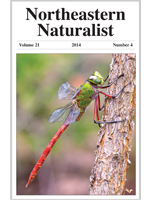Population declines of cavity-nesting birds are being recorded worldwide with degraded habitat, reduced prey availability, and limited nest-site availability implicated as potential causal factors for declines. A possible aid for avian species limited by breeding-site availability is the construction of nest boxes. Although nest boxes are commonly used for Falco sparverius (American Kestrels), little is known about the survival of young from fledging to the onset of migration. Using radiotelemetry, we recorded post-fledging survival and movement of 11 juvenile American Kestrels in northeastern Connecticut from June to September 2013. We used the Kaplan-Meier procedure, adjusted for staggered entry of individuals over time, to estimate daily survival at 0.270 (95% CI 0.01, 0.53) at the onset of migration. Causes of mortality included predation (n = 4 American Kestrels), exposure (n = 2), and unknown (n = 1). During the post-fledging period, the farthest net distance that we recorded for an American Kestrel from its natal box was 16.1 km. The 3 American Kestrels that we tracked from the nest box to the onset of migration demonstrated different patterns: one made a sudden, long-distance movement to a site 8 km away from the nest box; one undertook a series of 1–5-km movements away from the nest box and eventually settled in an area 2 km from the nest box; and one made consistent movements between the nest-box area and sites 1–5 km away. Our results indicate that although many young American Kestrels die within the first month of fledging, those that survive make pre-migratory movements up to 16 km from their nest box. Extending conservation and management efforts beyond the nest-box area may be an important step towards maintaining American Kestrel populations.
How to translate text using browser tools
1 March 2015
Survival and Movements of Post-Fledging American Kestrels Hatched from Nest Boxes
Annie E. Stupik,
Tom Sayers,
Min Huang,
Tracy A.G. Rittenhouse,
Chadwick D. Rittenhouse
ACCESS THE FULL ARTICLE

Northeastern Naturalist
Vol. 22 • No. 1
March 2015
Vol. 22 • No. 1
March 2015




